Characteristic features, Classification, structure, Reproduction | Botany - Algae | 11th Botany : Chapter 2 : Plant Kingdom
Chapter: 11th Botany : Chapter 2 : Plant Kingdom
Algae
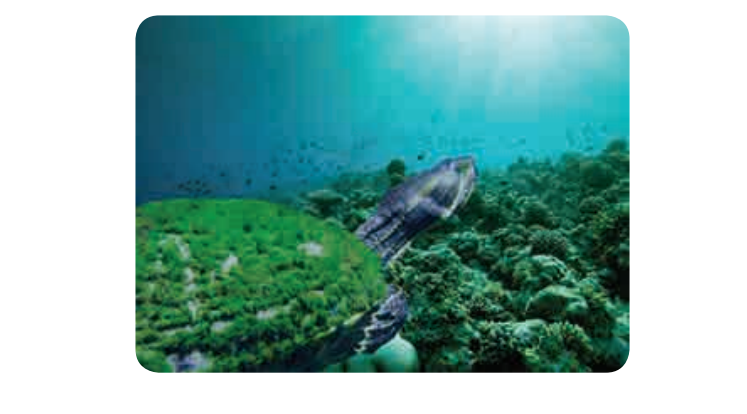
Algae
Rain brings joy and life to various organisms on
earth. Have you noticed some changes in and around you after the rain? Could
you identify the reason for the slippery nature of the terrace and green
patches on the wall of our home, green colour of puddles and ponds? Why should
we clean our water tanks very often? The reason is algae. Algae are simple
plants that lack true roots, true stems and true leaves. Two-third of our
earth’s surface is covered by oceans and seas. The photosynthetic plants called
algae are present here. More than half of the total primary productivity of the
world depends on this plant group. Further, other aquatic organisms also depend
upon them for their existence.
Algae are autotrophs, and grow in a wide range of
habitats. Majority of them are aquatic, marine (Gracilaria, and Sargassum)
and freshwater (Oedogonium, and Ulothrix) and also found in soils (Fritschiella, and Vaucheria ). Chlorella
lead an endozoic life in hydra and sponges whereas Cladophora crispata grow on the shells of molluscs. Algae are
adapted to thrive in harsh environment too. Dunaliella
salina grows in salt pans (Halophytic alga) . Algae growing in
snow are called Cryophytic algae. Chlamydomonas nivalis grow in snow covered mountains and impart red colour
to the snow (Red snow). A few algae
grow on the surface of aquatic plants and are called epiphytic algae ( Coleochaete,
and Rhodymenia) . The study of algae
is called algology or phycology.
Some of the eminent algologists
include F.E. Fritsch, F.E. Round, R.E. Lee, M.O.Parthasarathy Iyengar, M.S.
Randhawa, Y. Bharadwaja, V.S. Sundaralingam and T.V.Desikachary.
1. General Characteristic features
The algae show a great diversity in size, shape and
structure. A wide range of thallus organisation is found in algae. Unicellular
motile (Chlamydomonas), unicellular
non-motile (Chlorella), Colonial
motile (Volvox), Colonial non motile
(Hydrodictyon), siphonous (Vaucheria), unbranched filamentous (Spirogyra), branched filamentous (Cladophora), discoid (Coleochaete) heterotrichous ( Fritschiella), Foliaceous (Ulva) to Giant Kelps (Laminaria and Macrocystis). The thallus organization in algae is given in Figure 2.3.
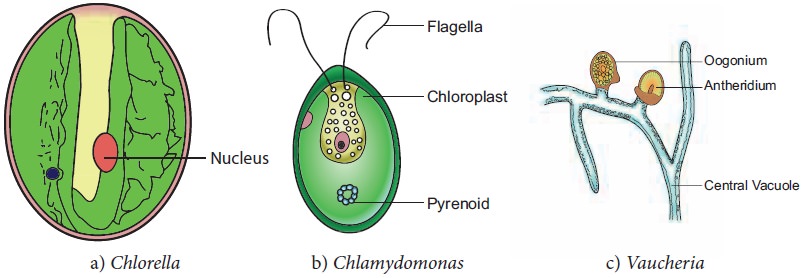
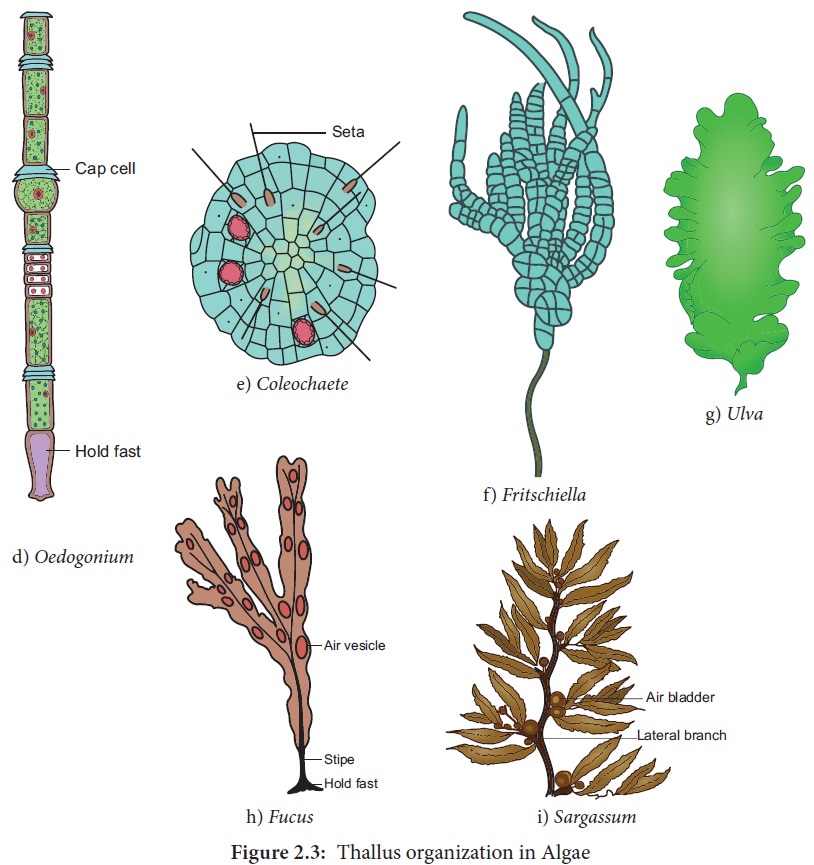
Algae are Eukaryotes except blue green algae. The plant body does not show differentiation into tissue systems. The cell wall of algae is made up of cellulose and hemicellulose. Siliceous walls are present in diatoms. In Chara the thallus is encrusted with calcium carbonate. Some algae possess algin, polysulphate esters of polysaccharides which are the sources for the alginate, agar agar and Carrageenan.
The cell has a membrane bound nucleus and cell organelles like
chloroplast, mitochondria, endoplasmic reticulum, golgi bodies etc., Pyrenoids
are present. They are proteinaceous bodies found in chromatophores and assist
in the synthesis and storage of starch. The pigmentation, reserve food material
and flagellation differ among the algal groups.

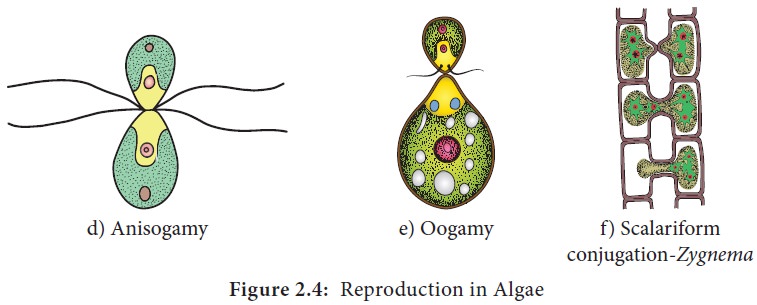
Algae reproduces by vegetative, asexual and sexual
methods (Figure 2.4). Vegetative reproduction includes fission (In unicellular
forms the cell divides mitotically to produce two daughter cells Example: Chlamydomonas); Fragmentation (fragments
of parent thallus grow into new individual Example: Ulothrix ) Budding (A lateral bud is formed in some members like Protosiphon and helps in reproduction) Bulbils, (a wedge shaped modified
branch develop in Sphacelaria)
Akinetes (Thick walled spores meant for perennation and germinates with the
advent of favourable condition Example: Pithophora).
Tubers (Structures found on the rhizoids and the lower nodes of Chara which store food materials).
Asexual reproduction takesplace by the production of zoospores( Ulothrix, Oedogonium) aplanospore(thin walled non motile spores Example: Vaucheria);
Autospores
(spores which look similar to parent cell Example: Chlorella ); Hypnospore (thick walled aplanospore – Example: Chlamydomonas nivalis); Tetraspores (Diploid thallus of Polysiphonia produce haploid spores
after meiosis).
Sexual reproduction in algae are of three types 1. Isogamy (Fusion of morphologically and Physiologically similar gametes Example: Ulothrix) 2. Anisogamy (Fusion of either morphologically or physiologically dissimilar gametes Example: Pandorina) 3. Oogamy (Fusion of both morphologically and physiologically dissimilar gametes.
Example:
Sargassum). The life cycle shows
distinct alternation of generation.
2. Classification
F.E. Fritsch proposed a classification for algae based on pigmentation, types of flagella, reserve food materials, thallus structure and reproduction. He published his classification in the book “The structure and reproduction of the Algae”(1935).
He classified algae into 11 classes namely
Chlorophyceae, Xanthophyceae, Chryso-phyceae, Bacillariophyceae,
Cryptophyceae, Dinophyceae, Chloromonadineae uglenophyceae, Phaeophyceae,
Rhodophy-ceae, Cyanophyceae (Table 2.2).
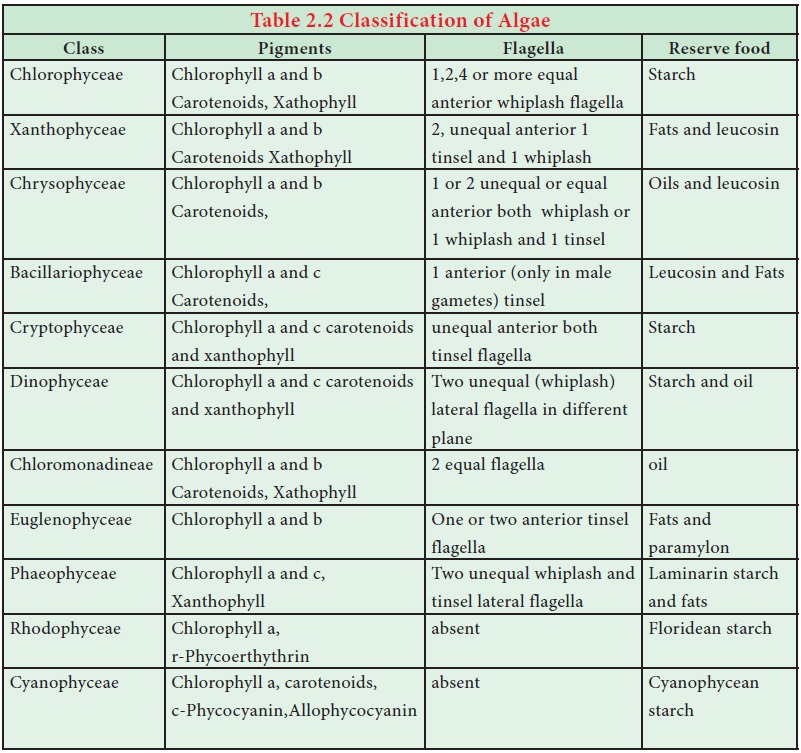
The salient features of Chlorophyceae, Phaeophyceae
and Rhodophyceae are given below.
Chlorophyceae
The members are commonly called ‘Green algae’ . Most of the species are aquatic(Fresh water-Spirogyra, Marine -Ulva). A few are terrestrial(Trentipohlia).
Variation among the shape of the chloroplast is found in members of algae. It
is Cup shaped (Chlamydomonas),
Discoid (Chara), Girdle shaped, (Ulothrix), reticulate (Oedogonium), spiral (Spirogyra), stellate(Zygnema), plate like(Mougeoutia). Chlorophyll ‘a’ and
Chlorophyll ‘b’ are the major photosynthetic pigments. Storage bodies called
pyrenoids are present in the chloroplast and store starch. They also contain
proteins. The cell wall is made up of inner layer of cellulose and outer layer
of Pectin. Vegetative reproduction takes place by means of fragmentation and
asexual reproduction is by the production of zoospores, aplanospores and
akinetes. Sexual reproduction is present and may be isogamous, anisogamous or
Oogamous. Examples for this group of algae includes Chlorella, Chlamydomonas,
Volvox, Spirogyra, Ulothrix, Chara and
Ulva.
Phaeophyceae
The members of this class are called ‘Brown algae’. Majority of the forms are found in marine habitats. Pleurocladia is a fresh water form. The thallus is filamentous (Ectocarpus) frond like (Dictyota)or may be giant kelps (Laminaria and Macrocystis). The thallus is differentiated into leaf like
photosynthetic part called fronds, a stalk like structure called stipe and a
holdfast which attach thallus to the substratum.
The Pigments include Chlorophyll a, c, carotenoids
and Xanthophylls. A golden brown pigment called fucoxanthin is present and it
gives shades of colour from olive green to brown to the algal members of this
group. Mannitol and Laminarin are the reserve food materials. Motile
reproductive structures are present. Two laterally inserted unequal flagella
are present. Among these one is whiplash and another is tinsel. Although sexual
reproduction ranges from isogamy to Oogamy, Most of the forms show Oogamous
type. Alternation of generation is present (isomorphic, heteromorphic or
diplontic). Examples for this group include Sargassum,
Laminaria, Fucus and Dictyota.
Rhodophyceae
Members of this group include ‘Red algae’ and are mostly marine. The thallus is multicellular,
macroscopic and diverse in form. Porphyridium
is the unicellular form. Filamentous (Goniotrichum)
ribbon like (Porphyra) are also
present. Corallina and Lithothamnion are heavily impregnated with lime and form coral reefs. Apart
from chlorophyll a, r-phycoerythrin and r-phycocyanin are the photosynthetic
pigments. Asexual reproduction takes place by means of monospores, neutral
spores and tetraspores.
The storage product is floridean starch. Sexual
reproduction is Oogamous. Male sex organ is spermatangium which produces
spermatium. Female sex organ is called carpogonium. The spermatium is carried
by the water currents and fuse with egg nucleus to form zygote. The zygote
develops into carpospores. Meiosis occurs during carpospore formation.
Alternation of generation is present. Examples for this group of algae include Ceramium, Polysiphonia, Gelidium, Cryptonemia and Gigartina.
3. Economic Importance
The Economic importance of Algae is given in Table
2.3.
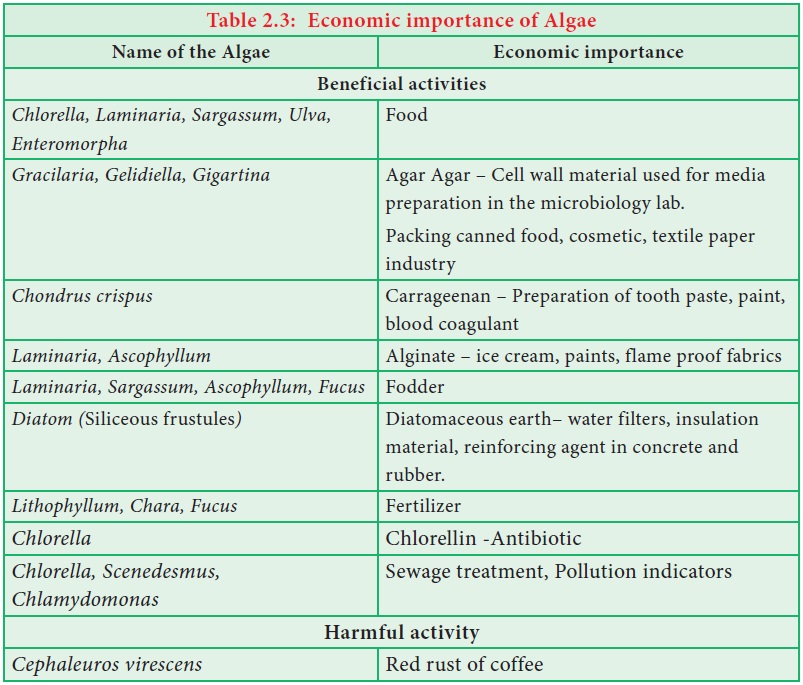
4. Oedogonium
Class – Chlorophyceae
Order - Oedogoniales
Family -Oedogoniaceae
Genus – Oedogonium
Oedogonium
is a freshwater
, filamentous alga and occurs in
ponds, lakes and stagnant water. The filaments are attached to rocks. Some are
epiphytic on aquatic plants. Oedogonium
terrestre is a terrestrial form and grow in moist soils. The young
filaments are attached but older ones are free floating.
Thallus
structure
The thallus is filamentous ,multicellular and
unbranched. All the cells of the filament are cylindrical except the basal and
apical cell. The basal cell is colourless and forms hold fast. The proximal end
of the hold fast extends to produce finger like projections which help the
filament to attach on the substratum. The apical cell is rounded or elongated
in shape. Each vegetative cell is cylindrical and possesses a thick cell wall.
The inner layer is cellulosic and the outer layer is made up of pectin. A thin
layer of chitin is present above the pectin layer. Next to the cell wall a
plasma membrane is present. A large vacuole is present. The protoplasm contains
reticulate chloroplast and it extends from one end of the cell to the other. A
single nucleus and many pyrenoids are present. The distal end of some cells
possess ring like markings called apical caps. Such cells are called cap cells.
The presence of cap cell is characteristic feature of Oedogonium (Figure 2.5).

Reproduction
Oedogonium
reproduces
by vegetative, asexual and sexual
methods. Vegetative reproduction takes place by fragmentation and akinete
formation. During asexual reproduction zoospores are formed. During favourable
conditions, some of the vegetative cells function as zoosporangia. Usually a
single zoospore is produced per zoosporangium. A ring of short flagella is
found at the base of colourless, beak like anterior end of the zoospore. This
kind of flagellation is called stephanokont. The zoospore is released from the
zoosporangium and swims in water (Figure 2.6). If it reaches a suitable
substratum, it divides into two cells. The lower cell forms holdfast. The green
upper cell divides and produces the filament.
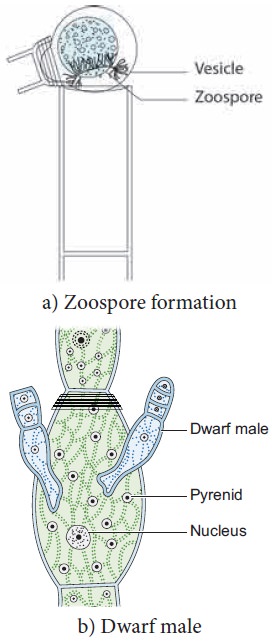

Figure
2.6: Reproduction in Oedogonium
Sexual reproduction is Oogamous. The male
gametangium is antheridium and female gametangium is called Oogonium. Based on
the distribution of sex organs there are two types of species namely
Macrandrous and Nannandrous.
Macrandrous monoecious – Antheridia and Oogonia
occur on same filament – Oedogonium
fragile.
Macrandrous dioecious – Antheridia and Oogonia
occur on separate filaments – Oedogonium
crassum
In nannadrous species antheridia are produced on reduced male filaments called dwarf male plants(O.cancatenatum).
In nannandrous species antheridia develop on
specialised 2–4 celled filaments called dwarf males. The dwarf male is
developed from androspores released from the androsporangium.. If the
androsporangia and oogonia develop on same filament, it is called gynandrosporous (O. concatenatum ). If they are borne on different filaments
it is called idioandrosporous (O. conferatum). The antheridium produces
multiflagellate antherozoids. They are released by transverse splitting of the
wall of antheridium. Antherozoids are attracted chemotactically towards the
mature oogonium. A single antherozoid enters the oogonium through the opening
present on the wall of the oogonium. The male nucleus fuses with the egg to
form a diploid zygote. After fertilization the zygote separates from the
oogonial wall and a thick wall is secreted around it. The diploid zygote
undergoes meiosis to produce 4 haploid multiflagellate zoospores. The wall of
the zygote ruptures to release the zoospores.The germination of the zoospore
produces haploid filaments of Oedogonium
(Figure 2.6).
In the life cycle of Oedogonium the diploid phase is short lived and is represented by
zygote. The haploid phase is predominant and life cycle is of Haplontic type (Figure 2.7).
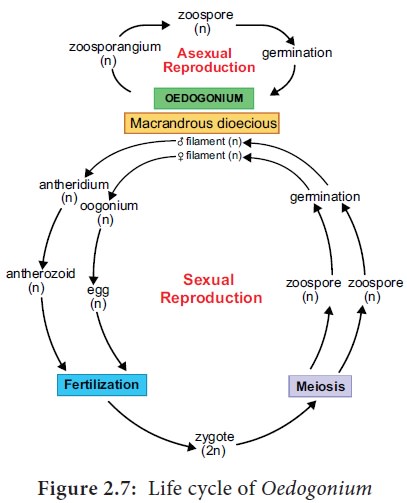
5. Chara
![]()
![]()
![]()
Class – Chlorophyceae
Order – Charales
Family – Characeae
Genus – Chara
Chara is
commonly called as ‘ stone wort’ It
is a submerged aquatic freshwater alga growing attached to the mud of the lakes
and slow running streams. Chara baltica
grows in saline water. The thallus is often encrusted with calcium and
magnesium carbonate.
Thallus
structure
The plant body is multicellular, macroscopic and is
differentiated into main axis and rhizoids. The rhizoids are thread-like,
multicellular structures arise from the lower part of the thallus or peripheral
cells of the lower node.They are characterised by the presence of oblique
septa. The rhizoids fix the main axis on the substratum and helps in the
absorption of salts and solutes (Figure
2.8).
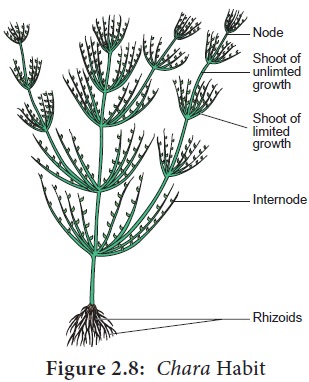
The cytoplasm is divided into outer ectoplasm and inner endoplasm. The endoplasm shows cytoplasmic streaming.
Reproduction
Chara reproduces
by vegetative and sexual methods.
Vegetative reproduction takes place by Amylum stars, Root bulbils, Amorphous
bulbils and secondary protonema.
Sexual reproduction - Sexual reproduction is
Oogamous. Sex organs are macroscopic and are produced on the branches of
limited growth. The male sex organ is called Antheridium or Globule and the
female sex organ is called Oogonium or Nucule (Figure 2.9). The Nucule is located above the Globule. The
antheridium is spherical, macroscopic and its wall is made up of eight cells
called shield cells. The antheridium has spermatogenous filaments. These
filaments produce antherozoids. The nucule is covered by five spirally twisted
tube cells and five coronal cells are present at the top of the nucule (Figure
2.9). The centre of the nucule
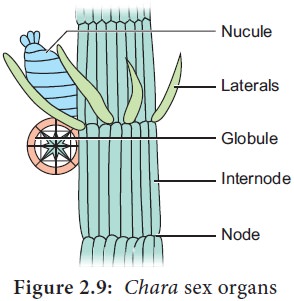
possesses a single egg. At maturity the tube cells
separate and a narrow slit is formed. The antherozoids penetrate the oogonium
and one of them fuses with the egg to form a diploid oospore. The oospore
secretes a thick wall around and germinates after the resting period. The
nucleus of the oospore divides to form 4 haploid daughter nuclei of which,
three degenerate. The oospore or zygote germinates to produce haploid
protonema. The plant body of Chara is
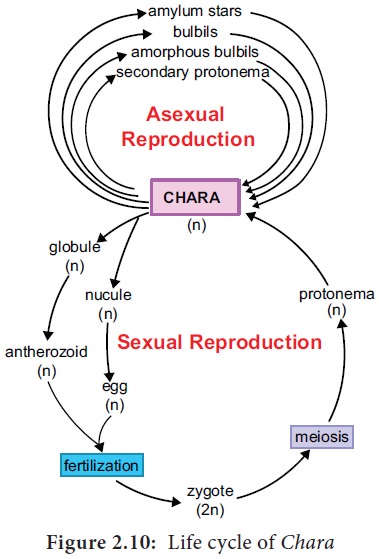
Related Topics